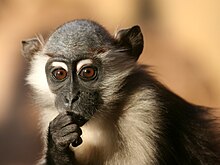Mangabey
| Mangabeys | |
|---|---|

| |
| Young cherry-crowned mangabey | |
| Scientific classification | |
| Domain: | Eukaryota |
| Kingdom: | Animalia |
| Phylum: | Chordata |
| Class: | Mammalia |
| Order: | Primates |
| Suborder: | Haplorhini |
| Infraorder: | Simiiformes |
| Family: | Cercopithecidae |
| Subfamily: | Cercopithecinae |
| Tribe: | Papionini |
| Groups included | |
| Cladistically included but traditionally excluded taxa | |
Mangabeys are West African Old World monkeys, with species in three of the six genera of tribe Papionini.
The more typical representatives of Cercocebus, also known as the white-eyelid mangabeys, are characterized by their bare, upper eyelids, which are lighter than their facial skin colouring, and the uniformly coloured hairs of their fur.[1] Members of Lophocebus, the crested mangabeys, tend to have dark skin, eyelids that match their facial skin, and crests of hair on their heads.
A new species, the highland mangabey, was discovered in 2003 and was initially placed in Lophocebus.[2] The genus Rungwecebus was later created for this species.[3]
Lophocebus and Cercocebus were once thought to be very closely related, so much so that all the species were in one genus,[4] but the species within genus Lophocebus are now thought to be more closely related to the baboons in genus Papio,[4] while the species within genus Cercocebus are more closely related to the mandrill.[5]
Genera
[edit]The three genera of mangabeys are:
- Lophocebus, the crested mangabeys
- Rungwecebus, the highland mangabey (kipunji)
- Cercocebus, the white-eyelid mangabeys
References
[edit]- ^ Chisholm, Hugh, ed. (1911). "mangabey". Encyclopædia Britannica (11th ed.). Cambridge University Press.
- ^ Jones, Trevor; Carolyn L. Ehardt; Thomas M. Butynski; Tim R. B. Davenport; Noah E. Mpunga; Sophy J. Machaga; Daniela W. De Luca (2005). "The Highland Mangabey Lophocebus kipunji: A New Species of African Monkey". Science. 308 (5725): 1161–1164. Bibcode:2005Sci...308.1161J. doi:10.1126/science.1109191. PMID 15905399. S2CID 46580799.
- ^ Davenport, Tim R. B.; William T. Stanley; Eric J. Sargis; Daniela W. De Luca; Noah E. Mpunga; Sophy J. Machaga; Link E. Olson (2006). "A New Genus of African Monkey, Rungwecebus: Morphology, Ecology, and Molecular Phylogenetics". Science. 312 (5778): 1378–81. Bibcode:2006Sci...312.1378D. doi:10.1126/science.1125631. PMID 16690815. S2CID 38690218.
- ^ a b Groves, C. P. (2005). "Genus Lophocebus". In Wilson, D. E.; Reeder, D. M. (eds.). Mammal Species of the World: A Taxonomic and Geographic Reference (3rd ed.). Baltimore: Johns Hopkins University Press. ISBN 0-801-88221-4. OCLC 62265494.
- ^ Groves, C. P. (2005). "Genus Cercocebus". In Wilson, D. E.; Reeder, D. M. (eds.). Mammal Species of the World: A Taxonomic and Geographic Reference (3rd ed.). Baltimore: Johns Hopkins University Press. ISBN 0-801-88221-4. OCLC 62265494.
Text is available under the CC BY-SA 4.0 license; additional terms may apply.
Images, videos and audio are available under their respective licenses.
